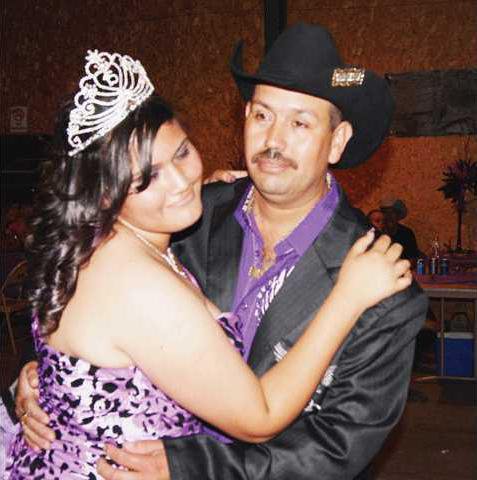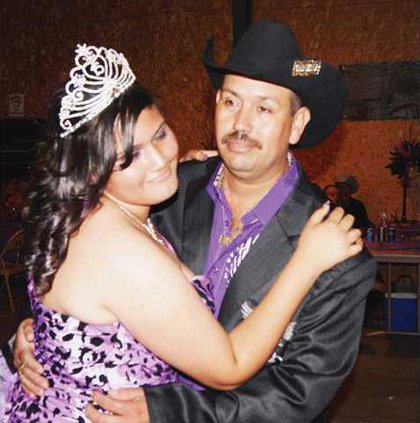Editors note: This is part two of a series about the tradition of quinceaneras, a coming of age celebration for young women of Hispanic decent. Last week, the focus was on the religious elements, and today the focus is on the party and all the trimmings. Great Bend’s population includes 20 percent people of hispanic decent, according to the 2010 U.S. Census. Quinceñeras are a popular custom celebrated often during the late spring through early fall months.
Coming of age ceremonies differ from culture to culture. In America, it’s common for 16-year olds to get their drivers license, or an 18-year old to graduate from high school and move into their own place. Twenty-one year olds mark their birthday with their first official purchase of a beer at the local bar.
Now, a coming of age ceremony that traces its origins to Mexico is becoming more and more common throughout the country, and in the Great Bend area. The quinceañera is the Mexican version of traditional “Sweet 16” party. For Great Bend teen Laura Leyva, June 9 marked her transformation from little girl to young woman. She started the day preparing to receive a formal blessing from her priest, Father Don Bedore, at St. Rose church. It was only the first of meaningful ceremonies to take place throughout the day.
Not every Hispanic girl celebrates her 15th birthday with a quinceañera, Leyva said. Not every celebration is as lavish either. Sometimes, it can be as simple as a party, and the priest will come to the house and offer a blessing. For Leyva, her quinceañera was something she had dreamed about having since whe was a little gir. She is the youngest of three sisters. Her two older sisters opted to receive a car instead, she said. Mrs. Leyva, her mother, grew up in Mexico, and didn’t have a quinceañera either. Leyva said she dreamed of having a party for several years.
The dress
One of the biggest considerations for the celebrant is the dress. Yeraldi’s Boutique in Great Bend, operated by Ivonne Sanchez, is often one of the first stops a girl and her mother will make when they begin preparing for the quinceañera.This is where she picks her colors, and those colors drive all the other choices of the event. It can take several weeks to get all the clothes together that the group will need.
According to Sanchez, the dress needs to be ordered at least three months in advance, and the entire outfit, including shoes and tiara will cost an average of $1,000.
Leyva and her mother chose a floor length dress of purple and black. Her court of chambelains wore long-sleeved purple shirts with black vests and pants, and her attendants wore purple dresses. Mom and dad both wore her colors too.
The Party
After the Leyva family finished the blessing at the church, photographer Javier Alvarez hopped in his car and followed the girl and her parents to the party. Leyva estimates over 300 people attended. That’s about average, with many parties seeing double the number of guests.
With guest lists of this size, hall rental is a necessity. The Barton County Extension office says they have several booked throughout the summer at the 4-H buildings north of town. Camp Aldrich north of Ellinwood is another popular venue, along with various halls in and around the city.
When a family begins to plan the event, all the expenses need to be taken into account. It all adds up to thousands of dollars with hall rental, deposits, decor, food, drink, dj service, the cake, as well as the clothes, Enter the tradition of the padrinos.
Padrinos are family and friends who sponsor different aspects of the quinceañera so the family of the celebrant is not overly burdened with the cost of the celebration. This is a Mexican cultural tradition, where those who have more take care of more on their own, and those with less share the burden more. Mrs. Leyva said it comes down to people in the community helping each other out.
“The culture of Mexicans is to help out family and friends so it is not too expensive for any family,” she said.
There is always a time during the party where the celebrant’s family publicly thanks each of the sponsors.
Changing of the shoes
Leyva started the morning by putting on a pair of white Converse sneakers her mother had decorated for her before putting on her dress and having her makeup applied and hair styled.
“The tennis shoes are pure white, signifying that she is a little girl,” alvarez said. The tradition is , La Quinceañera wears the low-profile shoes she would wear as a girl during the day. She will wear her floor length gown, so the shoes do not show, but are important later in the day when the dance begins.
Before the dance, the father and daughter, or in Leyva’s case, the grandfather and granddaughter, will take part in the changing of the shoes. First, Dad dances with his little girl, still wearing her flat shoes. Then she is taken to a seat of honor, where she receives her tiara, and the changing of the shoes takes place.
“The girl’s father takes off her tennis shoes and dresses her feet in a pair of high heels,” Alvarez said. “The high heels are a way to present her to society as a woman.”
After he presents the heels, the young woman dances her first dance with her father, just the two of them, as family and friends look on.
“I get some really good pictures during that dance,” Alvarez said. “Sometimes, I catch some really tough guys crying during that dance, and I’ll go up to them later and say, “You were crying?” and they’ll deny it.”
Then, its time for the chambelains to take their places at the side of the celebrant. They are her “dance court”, Alvarez said. Made up of the male friends and relatives of the girl, they will surround her for the rest of the dance. There is often a special chambelain de honor, sometimes but not always a boyfriend, that accompanies the celebrant for the evening. Often, there are several female attendants too, made up of the friends and family of La Quinceañera.
“They dress in the same color as the girl of honor,” Alvarez said. “Its all about friends and family.”
Leyva said her court included seven chambelains including her special, and six attendants -- her sister, two cousins, and the rest friends. More often, area girls include their non-hispanic friends in their party of attendants, something Father Don Bedore with St. Patrick’s Parish in Great Bend sees as a positive sign of cultural acceptance.
The trimmings
Another tradition is the doll ceremony. The father presents his daughter with what will be her last childhood doll. The doll’s dress matches the celebrant’s, and is ordered months ahead of time along with the rest of the clothes. At the ceremony, the youngest girls will gather around the birthday girl and and one of them will go home with the doll after the celebrant tosses it into the crowd.
During a dance break, the spotlight falls on the cake. Decorated lavishly in the celebrant’s colors, and usually several tiers, the cake is one of the hallmarks of the celebration. The birthday girl cuts the cake, and is the first to eat from it. Friends and family serve the rest of the guests.
According to Alvarez, traditionally, the party was more a celebration for the parents than for the girl, but times are changing. After Leyva cut the cake, Alvarez asked the birthday girl to wave goodbye to the camera, and he faded out. Dancing and partying went on into the night, as the tired photographer went home to his own family.
It’s just a matter of time before Alvarez will be putting together his own daughter’s celebration. She’s little now, but knows what she wants.
“Pink,” he said with a smile. “She says she wants a big, pink dress.”
More than just a birthday party
Part 2





